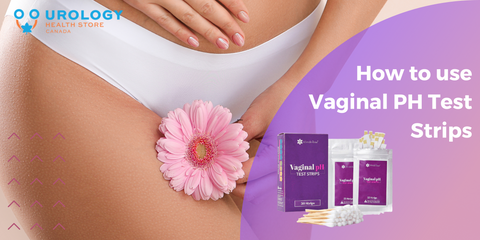Vaginal PH Test Trips
Experiencing discomfort like vaginal itching, a burning sensation while urinating, or noticing unusual vaginal discharge? A simple and convenient solution is available for you right at home – the vaginal pH test. It can play a crucial role in confirming or ruling out a vaginal infection, such as Bacterial Vaginosis (BV), and determining if you need medical intervention.
In this article, we'll explore the ease and effectiveness of self-testing kits for measuring your vaginal pH. We'll also delve into the practical aspects of conducting a vaginal pH test at home and discuss a couple of natural supplements, as well as lifestyle adjustments, that can help maintain a balanced vaginal pH and reduce the risk of future infections.
What is a Vaginal pH test?
The vaginal pH test is a straightforward method to gauge the acidity or alkalinity of your vaginal environment. Typically, a healthy vagina registers a pH level between 3.8 and 4.5 on a scale from 1 to 14. If your pH measurements exceed this range, it's often an indication of an irregular condition that may necessitate medical attention.
Why Do Women Use Feminine pH Test Strips?
For women encountering discomforting symptoms such as vaginal itching, a burning sensation during urination, or unusual vaginal discharge, the natural instinct might be to assume a yeast infection and seek relief through over-the-counter treatments. However, these symptoms can sometimes be misleading and may also align with another common condition known as Bacterial Vaginosis (BV). Over-the-counter medications are often ineffective in addressing BV.
Given the overlapping symptoms of BV and yeast infections, the need for accurate diagnosis becomes crucial. This is where at-home vaginal pH tests step in as invaluable tools. By measuring your vaginal pH level, you can gain insights into which condition you might be facing.
For instance, a pH level exceeding 4.5 could indicate BV, which typically requires antibiotics for treatment. On the other hand, if you're experiencing the symptoms mentioned above along with a pH level ranging from 4.0 to 4.5, it's more likely to be a yeast infection, which can often be managed without antibiotics.
In addition to providing clarity regarding your condition, understanding your vaginal pH can also be essential for overall vaginal health. A balanced pH level helps to maintain the natural protective mechanisms of the vagina, reducing the risk of infections and discomfort. By regularly monitoring your vaginal pH and making necessary lifestyle adjustments, you can promote a healthier and more comfortable experience while maintaining your vaginal well-being.
How do I Read the Results of a PH Test?
If you possess a pH color reference chart, use it to compare the results of the test paper and ascertain your vaginal pH levels. On the pH scale, which spans from 1 to 14, a healthy vaginal pH usually falls within the range of 3.8 to 4.5, representing a mildly acidic environment.
Should the readings dip below 3.8, it suggests that the vaginal pH is more acidic than the norm, whereas measurements surpassing 4.5 indicate an elevated alkaline state in the vagina.
It's essential to note that an acidic vaginal environment, on its own, is not typically responsible for infections. However, it can affect fertility since sperm tends to thrive in an alkaline setting. This is why, during sexual intercourse, the vaginal pH naturally rises to create an ideal alkaline environment for sperm, returning to its normal levels afterward.
Conversely, an alkaline or above-average pH level when not related to sexual activity is often an indicator of Bacterial Vaginosis (BV). In such cases, it is advisable to promptly consult your healthcare provider for a confirmed diagnosis and appropriate antibiotic treatment.
A Step-By-Step Guide on How to Use a Vaginal pH Test at Home
When using an at-home vaginal pH test kit, you'll typically discover a pH test paper and a colour chart for interpreting your results. It's worth noting that some kits might provide a simple "normal" or "abnormal" result, so if you're seeking precise pH readings, it's essential to check the contents of your kit before purchase.
-
Prepare Your Kit: Before you begin the test, open the pH color chart and have it readily accessible for later reference.
-
Cleanse Your Hands: Start by washing your hands thoroughly to ensure that they are free from any contaminants.
-
Handle the pH Test Paper: Using your thumb and index finger, grasp the handle of the swab and gently remove the piece of pH paper from its packaging. Be cautious not to let it come into contact with any other surfaces or substances.
-
Prepare for the Test: With your free hand, gently open the vaginal lips. Position the swab in such a way that, when inserted, the pH paper makes contact with the inner vaginal wall.
-
Conduct the Test: Allow the pH paper to remain in contact with the vaginal wall for approximately 5 seconds.
-
Retrieve the Swab: After the 5-second interval, gently remove the swab, taking care to prevent the pH paper from coming into contact with any other surfaces or substances.
Experiencing discomfort like vaginal itching, burning sensations, or unusual vaginal discharge may be indicative of bacterial vaginosis or a yeast infection. Using an at-home vaginal pH test can be a valuable tool to accurately diagnose your condition and facilitate appropriate treatment.
If you're new to the concept of using a vaginal pH test at home, refer to the instructions provided above for guidance on how to proceed.
You can purchase a Kit through Urology Health Store HERE
Centers For Disease Control & Prevention - Bacteria Vaginosis - https://www.cdc.gov/std/bv/stdfact-bacterial-vaginosis.htm
U.S. Food & Drug Administration – Home Use Vaginal pH Tests - https://www.fda.gov/medical-devices/home-use-tests/vaginal-ph




